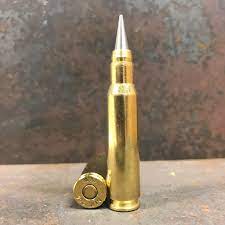Military
Armor Piercing Turkey - Turkish Manufacturer

Armor piercing (AP) is a type of ammunition that is designed to penetrate through armor or other types of protective materials. It is commonly used in military and law enforcement applications, where it is often necessary to defeat armored vehicles or protective gear worn by enemy personnel. The term "armor piercing" can also refer to a weapon or device that is designed specifically to defeat armor, such as an armor-piercing projectile or an armor-piercing rifle.
Armor-piercing ammunition is typically made of a hard, dense material that is capable of penetrating armor or other protective materials. This can include materials like steel, tungsten, or even depleted uranium. The bullet is often designed with a sharp, pointed tip and a slender body to help it penetrate through the armor more effectively.
Armor-piercing ammunition is generally not suitable for use against unarmored targets, as the high velocity and penetration capabilities of the bullet may cause excessive damage or overpenetration. It is important to use the appropriate type of ammunition for the specific target and situation
In military applications, armor-piercing ammunition is often used against enemy vehicles, such as tanks or armored personnel carriers. It can also be used against fortifications or other hardened targets.
In law enforcement, armor-piercing ammunition may be used in certain situations where officers need to defeat protective gear worn by a suspect, such as body armor. However, its use is generally limited to specialized units or exceptional circumstances, as it can pose a risk to bystanders or cause excessive damage to property.
The use of armor-piercing ammunition is regulated in some countries, as it can pose a risk to civilians or to law enforcement officers who may be wearing body armor. For example, in the United States, federal law prohibits the manufacture, importation, sale, or possession of armor-piercing handgun ammunition, except for certain limited exceptions.
Some types of armor-piercing ammunition, such as those made with depleted uranium, can be controversial due to the potential health and environmental risks associated with the use of these materials.
Armor piercing ammunition is typically more expensive than standard ammunition, due to the specialized materials and design required to achieve its armor-defeating capabilities.
The effectiveness of armor piercing ammunition depends on several factors, including the type of armor it is being used against, the thickness and composition of the armor, the distance from the target, and the caliber and design of the bullet. Different types of armor piercing bullets are optimized for different types of armor and may be more or less effective against different types of targets.
In some cases, armor piercing ammunition may be used in combination with other types of ammunition to achieve a desired effect. For example, a military vehicle might be equipped with a mix of armor piercing and high explosive rounds to allow it to engage a variety of different types of targets.
Some types of armor piercing ammunition, such as those made with tungsten, can be more environmentally friendly than those made with other materials, as they do not produce hazardous by-products when they are fired.
Armor Piercing Turkey - Turkish Manufacturer
Armor Piercing Turkey - Turkish Manufacturer
Armor piercing (AP) is a type of ammunition that is designed to penetrate through armor or other types of protective materials. It is commonly used in military and law enforcement applications, where it is often necessary to defeat armored vehicles or protective gear worn by enemy personnel. The term "armor piercing" can also refer to a weapon or device that is designed specifically to defeat armor, such as an armor-piercing projectile or an armor-piercing rifle.
Armor-piercing ammunition is typically made of a hard, dense material that is capable of penetrating armor or other protective materials. This can include materials like steel, tungsten, or even depleted uranium. The bullet is often designed with a sharp, pointed tip and a slender body to help it penetrate through the armor more effectively.
Armor-piercing ammunition is generally not suitable for use against unarmored targets, as the high velocity and penetration capabilities of the bullet may cause excessive damage or overpenetration. It is important to use the appropriate type of ammunition for the specific target and situation
In military applications, armor-piercing ammunition is often used against enemy vehicles, such as tanks or armored personnel carriers. It can also be used against fortifications or other hardened targets.
In law enforcement, armor-piercing ammunition may be used in certain situations where officers need to defeat protective gear worn by a suspect, such as body armor. However, its use is generally limited to specialized units or exceptional circumstances, as it can pose a risk to bystanders or cause excessive damage to property.
The use of armor-piercing ammunition is regulated in some countries, as it can pose a risk to civilians or to law enforcement officers who may be wearing body armor. For example, in the United States, federal law prohibits the manufacture, importation, sale, or possession of armor-piercing handgun ammunition, except for certain limited exceptions.
Some types of armor-piercing ammunition, such as those made with depleted uranium, can be controversial due to the potential health and environmental risks associated with the use of these materials.
Armor piercing ammunition is typically more expensive than standard ammunition, due to the specialized materials and design required to achieve its armor-defeating capabilities.
The effectiveness of armor piercing ammunition depends on several factors, including the type of armor it is being used against, the thickness and composition of the armor, the distance from the target, and the caliber and design of the bullet. Different types of armor piercing bullets are optimized for different types of armor and may be more or less effective against different types of targets.
In some cases, armor piercing ammunition may be used in combination with other types of ammunition to achieve a desired effect. For example, a military vehicle might be equipped with a mix of armor piercing and high explosive rounds to allow it to engage a variety of different types of targets.
Some types of armor piercing ammunition, such as those made with tungsten, can be more environmentally friendly than those made with other materials, as they do not produce hazardous by-products when they are fired.


